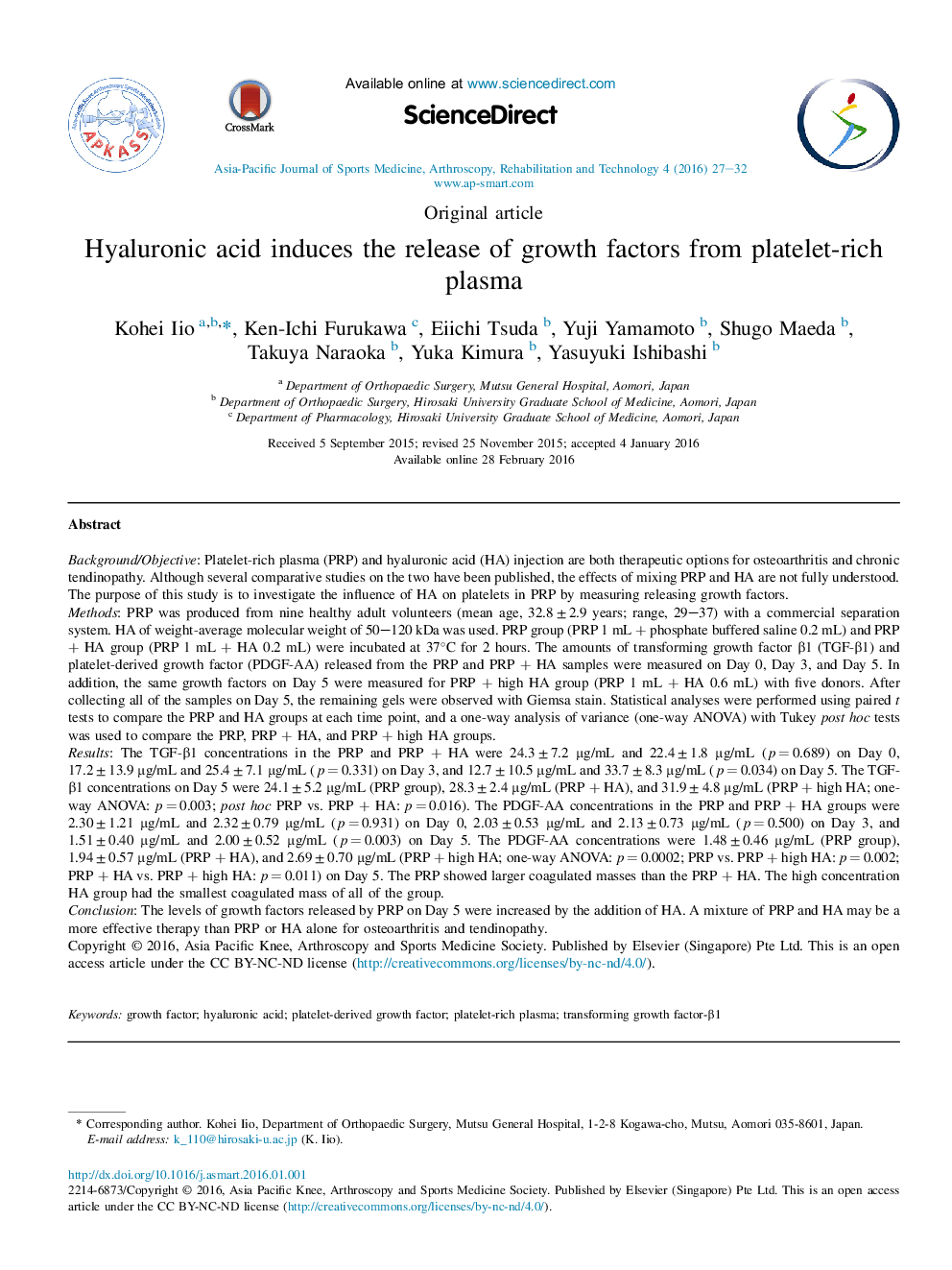| کد مقاله | کد نشریه | سال انتشار | مقاله انگلیسی | نسخه تمام متن |
|---|---|---|---|---|
| 2739493 | 1567050 | 2016 | 6 صفحه PDF | دانلود رایگان |
Background/ObjectivePlatelet-rich plasma (PRP) and hyaluronic acid (HA) injection are both therapeutic options for osteoarthritis and chronic tendinopathy. Although several comparative studies on the two have been published, the effects of mixing PRP and HA are not fully understood. The purpose of this study is to investigate the influence of HA on platelets in PRP by measuring releasing growth factors.MethodsPRP was produced from nine healthy adult volunteers (mean age, 32.8 ± 2.9 years; range, 29–37) with a commercial separation system. HA of weight-average molecular weight of 50–120 kDa was used. PRP group (PRP 1 mL + phosphate buffered saline 0.2 mL) and PRP + HA group (PRP 1 mL + HA 0.2 mL) were incubated at 37°C for 2 hours. The amounts of transforming growth factor β1 (TGF-β1) and platelet-derived growth factor (PDGF-AA) released from the PRP and PRP + HA samples were measured on Day 0, Day 3, and Day 5. In addition, the same growth factors on Day 5 were measured for PRP + high HA group (PRP 1 mL + HA 0.6 mL) with five donors. After collecting all of the samples on Day 5, the remaining gels were observed with Giemsa stain. Statistical analyses were performed using paired t tests to compare the PRP and HA groups at each time point, and a one-way analysis of variance (one-way ANOVA) with Tukey post hoc tests was used to compare the PRP, PRP + HA, and PRP + high HA groups.ResultsThe TGF-β1 concentrations in the PRP and PRP + HA were 24.3 ± 7.2 μg/mL and 22.4 ± 1.8 μg/mL (p = 0.689) on Day 0, 17.2 ± 13.9 μg/mL and 25.4 ± 7.1 μg/mL (p = 0.331) on Day 3, and 12.7 ± 10.5 μg/mL and 33.7 ± 8.3 μg/mL (p = 0.034) on Day 5. The TGF-β1 concentrations on Day 5 were 24.1 ± 5.2 μg/mL (PRP group), 28.3 ± 2.4 μg/mL (PRP + HA), and 31.9 ± 4.8 μg/mL (PRP + high HA; one-way ANOVA: p = 0.003; post hoc PRP vs. PRP + HA: p = 0.016). The PDGF-AA concentrations in the PRP and PRP + HA groups were 2.30 ± 1.21 μg/mL and 2.32 ± 0.79 μg/mL (p = 0.931) on Day 0, 2.03 ± 0.53 μg/mL and 2.13 ± 0.73 μg/mL (p = 0.500) on Day 3, and 1.51 ± 0.40 μg/mL and 2.00 ± 0.52 μg/mL (p = 0.003) on Day 5. The PDGF-AA concentrations were 1.48 ± 0.46 μg/mL (PRP group), 1.94 ± 0.57 μg/mL (PRP + HA), and 2.69 ± 0.70 μg/mL (PRP + high HA; one-way ANOVA: p = 0.0002; PRP vs. PRP + high HA: p = 0.002; PRP + HA vs. PRP + high HA: p = 0.011) on Day 5. The PRP showed larger coagulated masses than the PRP + HA. The high concentration HA group had the smallest coagulated mass of all of the group.ConclusionThe levels of growth factors released by PRP on Day 5 were increased by the addition of HA. A mixture of PRP and HA may be a more effective therapy than PRP or HA alone for osteoarthritis and tendinopathy.
Journal: Asia-Pacific Journal of Sports Medicine, Arthroscopy, Rehabilitation and Technology - Volume 4, April 2016, Pages 27–32
